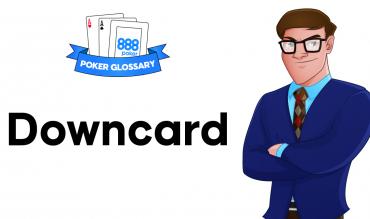Explanation of Downcard
Stud games do not make use of community cards (with one specific exception – see glossary entry community cards) but this does not mean that there are no cards which are visible to the entire table. Through the seven streets in a stud hand players are dealt a combination of upcards and downcards. Although upcards belong exclusively to the player they are dealt (other players can’t use them), they are visible to the entire table.
On third street (the first betting round), players are dealt two downcards and one upcard. On each of fourth, fifth, and sixth street, players are dealt one up-card. The final card is dealt on seventh street (aka “the river”) and is a down card. Stud players are hence dealt a total of seven cards throughout the hand (provided they don’t fold), and that hand is comprised of 3 downcards and 4 upcards.
Stud hands are often represented as follows where the downcards are shown in brackets. (xx)xxxx(x).
For example “On third street I was dealt the (Kc2s)3h”
Example of Downcard used in a sentence -> In Stud games we are dealt two downcards and one upcard on third street.
How to Use Downcard as Part of Your Poker Strategy
Downcards are similar to hole-cards in Hold’em. They should be kept secret and not shown to any other player at the table.
Since downcards are not revealed to the table they can result in the ability to make deceptively strong holdings. If the majority of the cards which contribute to our hand strength our downcards, we can consider our hand as deceptively strong.
If the majority of the cards which contribute to our hand strength are upcards, the relative strength of our holding is lessened since the absolute strength is somewhat telegraphed. Our opponent will realise we are often strong and may be reluctant to give us action. If he does give us action we’ll wonder why he is happy to invest so many additional chips into the pot despite the strong nature of our upcards. (It might imply that he has an even stronger holding than ours).
See Also


